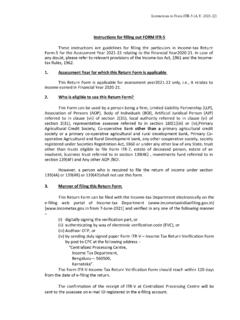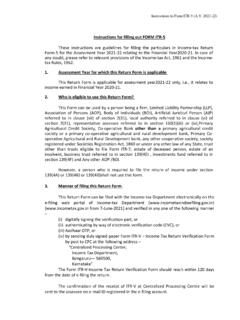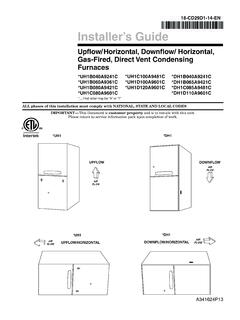Transcription of SPEED RESTRICTION / ADJUSTMENT: SPEED BELOW …
1 Chap 4 SPEED , Altitude & Jet SPEED LIMITS : ( , , AIM , , 4-2-11, 4-4-12, 5-3-7, 5-4-7, 5-5-9, AC 90-66A, Controller's Handbook , FAA-H-8083-3A, FAA-H-8083-15A, FAA-H-8083-25A, FAA-H-8261-1A). BELOW 10,000 ft .. 250 KIAS. Class B .. 250 KIAS BELOW 10,000 ft (unrestricted at or above 10,000). Beneath Class B .. 200 KIAS (or in VFR corridor through a Class B). Procedure Turn .. 200 KIAS. Class C or D ( BELOW 2,500 AGL within 4NM of the airport) .. 200 (unless a higher SPEED is specifically approved by ATC). Class E or G Airport Traffic Pattern .. 200 KIAS (recommended). (d) If the minimum safe airspeed for any particular operation is greater than the maximum SPEED prescribed in this section, the aircraft may be operated at that minimum SPEED . NOTE: There is no requirement to advise ATC when exceeding a SPEED for this reason.
2 SPEED RESTRICTION / adjustment : (AIM 4-4-12). 1. If a controller issues a SPEED RESTRICTION while vectoring you, it continues to apply with an altitude change. 2. An approach clearance cancels any previously assigned SPEED adjustment (however the controller would not anticipate a large SPEED INCREASE when close to the runway). Pilots are expected to make their own SPEED adjustments to complete the approach unless the adjustments are restated. SPEED adjustments should not be assigned inside the final approach fix on final or a point 5 miles from the runway, whichever is closer to the runway. 3. It is the pilot's responsibility and prerogative, to refuse a SPEED adjustment that he or she considers excessive or contrary to the aircraft's operating limitations with a comfortable margin for safety. SPEED BELOW 10,000 and/or in CLASS B: ( , , ).
3 1. SPEED 250 KIAS BELOW 10,000 feet (or 200 KIAS BELOW the floor or in VFR corridor). 250 KNOTS. MUST NOT be EXCEEDED even if you are told to MAINTAIN BEST FORWARD SPEED .. 2. Maintain maximum (or best) forward SPEED means maximum or best forward LEGAL' SPEED .. ATC does not have the authority to lift the 250 BELOW 10,000 SPEED RESTRICTION [ (a)]. You cannot be cleared to violate a regulation, and you cannot accept such a clearance. 3. At 10,000 feet and above, in Class B airspace, you can go as fast as you want unless issued a SPEED RESTRICTION by ATC. 4. If a controller assigns you 300 kts or greater inbound (10,000 or above), and then later descends you to 8,000, it is UNDERSTOOD that you must SLOW to 250 kts BEFORE descending BELOW 10,000. 5. NOTE: There was a test program that took place at HOUSTON International (IAH) to delete the 250 kts BELOW 10,000 for DEPARTURES only, AND only if authorized by ATC.
4 The phraseology was NO. SPEED LIMIT or INCREASE SPEED TO (number) KNOTS or DELETE the 250 kt RESTRICTION or CLIMB UNRESTRICTED or HIGH SPEED CLIMB APPROVED . This program was cancelled in January of 2004. Currently an air traffic controller does not have the authority to authorize a SPEED above 250 kts BELOW 10,000 anywhere in the United States. 6. The SPEED RESTRICTION : 250 kts BELOW 10,000 does NOT apply to aircraft operating beyond 12 NM from the coastline of the United States. ( , , , AIM 4-4-12). SPEED in CLASS C, D, E and G Airport Areas: ( , AC 90-66A, FAA-H-8083-3A, FAA-H-8083-15A). 1. Unless otherwise authorized or required by ATC, no aircraft may operate at or BELOW 2,500 AGL within 4 NM of the primary airport of a Class C or Class D at an indicated airspeed of more than 200 knots. 2. maintain best forward SPEED is NOT an authorization to exceed the 200 kts in Class C or D.
5 3. Any SPEED deviation above 200 kts must be specifically assigned by ATC ( maintain 220 kts ). 4. It is RECOMMENDED that while operating in the traffic pattern at an airport WITHOUT an operating control tower the pilot maintain an airspeed of no more than 200 knots. In any case, the SPEED should be adjusted, when practicable, so that it is compatible with the SPEED of other airplanes in the pattern. Never let an airplane take you someplace your brain didn't get to five minutes earlier. 108 EVERYTHING EXPLAINED for the Professional Pilot Chap 4 SPEED , Altitude & Jet V SPEEDS V means VELOCITY. V1 Takeoff decision SPEED for jets, turboprops or Transport category aircraft . Engine failure BELOW V1 takeoff must be aborted and the aircraft brought to a stop on the runway. Engine failure at or ABOVE V1 mandates the pilot continue the takeoff accelerate to VR and after rotation accelerate to V2.
6 Does not apply to most light, prop-driven twins because they cannot continue a takeoff roll and accelerate on one engine; there is no choice but to abort. V2 Takeoff safety SPEED for jets, turboprops or Transport category aircraft Best climb gradient SPEED , best altitude increase per mile with the most critical engine inop twin engine aircraft with an engine inop are guaranteed a climb gradient (24 ft UP per 1,000 ft FORWARD) min SPEED to be maintained to at least 400 ft AGL. V2 MIN Minimum takeoff safety SPEED . Usually times stall SPEED in takeoff configuration. VA Design mAneuvering SPEED The highest safe airspeed for abrupt control deflection or for operation in turbulence or severe gusts. If only one SPEED is published it is usually determined at max landing weight. This SPEED decreases as weight decreases.
7 Formula for determining VA at less than max landing weight: VA2 = VA x current weight max lndg weight VABE Maximum SPEED for Air-Brake Extension. VABO Maximum SPEED for Air-Brake Operation. VAC Missed Approach Climb SPEED for flap configuration with critical engine inop ( climb gradient). VAP APproach target SPEED . VREF + configuration (flaps/slats setting) & wind factor. Typically add (to VREF) the headwind component + all the gust factor (to a max of 20 knots). VB Design SPEED for maximum gust intensity for Transport-category aircraft or other aircraft certified under Part 25. Turbulent-air-penetration SPEED that protects the structure in 66-fps gusts. VC Design Cruising SPEED . SPEED the aircraft was designed to cruise at. The completed aircraft may actually cruise slower or faster than VC. It is the highest SPEED at which the structure must withstand the FAA's hypothetical standard 50-fps gust.
8 VD Design Diving SPEED The aircraft is designed to be capable of diving to this SPEED (in very smooth air) and be free of flutter, control reversal and buffeting. Control surfaces have a natural vibration frequency where they begin to flutter like a flag in a stiff breeze. If flutter begins, it can become catastrophic in a matter of seconds. It can worsen until the aircraft is destroyed even if airspeed is reduced as soon as flutter begins. VDEC Accelerate/Stop DECision SPEED for multiengine piston and light multiengine turboprops. VDF / Demonstrated-Flight Diving SPEED VDF is in knots. MDF is in a percentage of Mach number. MDF Some aircraft are incapable of reaching VD because of lack of power or excess drag. When this is the case, the test pilot dives to the maximum SPEED possible the demonstrated-flight diving SPEED .
9 VEF SPEED at which the critical engine is assumed to fail during takeoff (used in certification tests). VENR ENRoute climb SPEED with critical engine inop accelerate to VENR above 1,500 AGL. VF Design Flap SPEED During the design phase, the flaps are designed to be operated at this maximum SPEED . If the engineers did a good job, the actual flap SPEED VFE will be the same. VFC / Maximum SPEED for undesirable Flight Characteristics must be regarded with the same respect as VNE Red line. Instability could develop beyond the pilot's ability to recover. VFC is expressed in knots; MFC is expressed in a percentage of MFC Mach number. VFE Maximum Flap-Extended SPEED Top of white arc Highest SPEED permissible with wing flaps in a prescribed extended position. Many aircraft allow the use of approach flaps at speeds higher than VFE.
10 Positive load for Normal category airplanes is usually reduced from + to + with the flaps down, and negative load is reduced from to Zero. The purpose of flaps during landing is to enable steeper approaches without increasing the airspeed. VFR Flap Retract SPEED minimum SPEED required for flap retraction after takeoff. VFS Final Segment SPEED (jet takeoff) with critical engine inop. Accelerate to VFS at 400 feet AGL. VFTO Final TakeOff SPEED end of the takeoff path en route configuration one engine inoperative. VH Maximum SPEED in level flight with maximum continuous power. Mainly used for aircraft advertising. Ultralights are limited by Part 103 to a VH of 55 knots. VLE Maximum Landing gear Extended SPEED Maximum SPEED at which an airplane can be safely flown with the landing gear extended. In an EMERGENCY, FORGET ABOUT THIS SPEED , THROW THE GEAR OUT!







